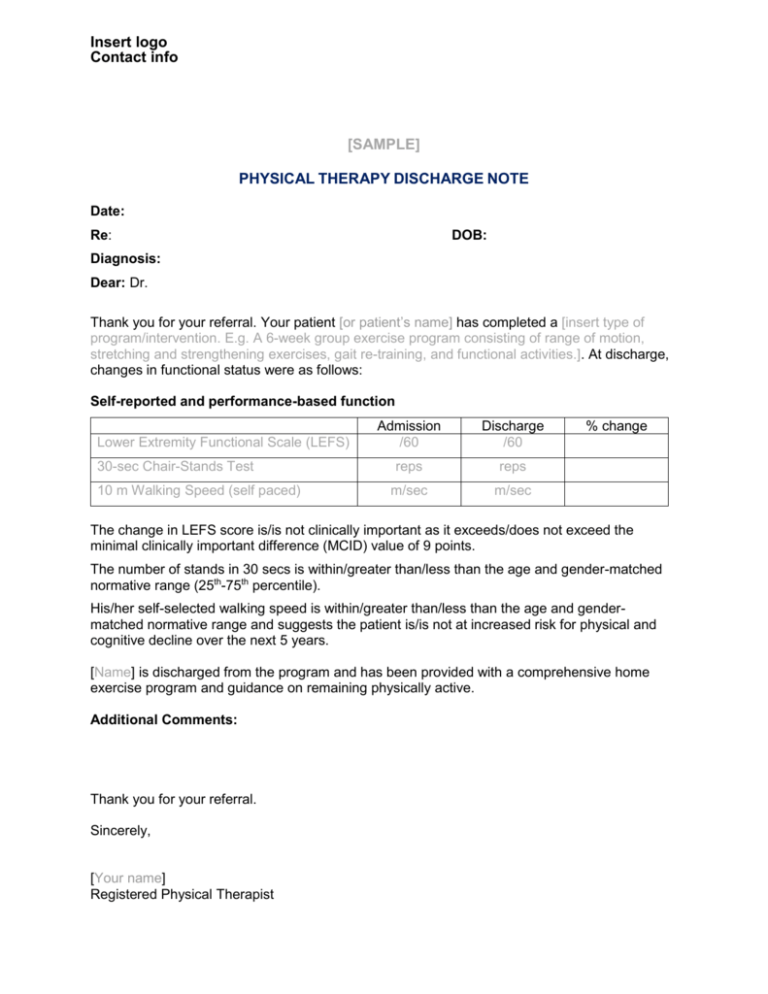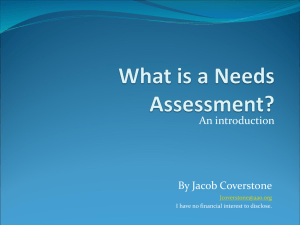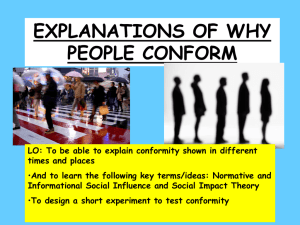Physical Therapy Discharge Note Template
advertisement

Insert logo Contact info [SAMPLE] PHYSICAL THERAPY DISCHARGE NOTE Date: Re: DOB: Diagnosis: Dear: Dr. Thank you for your referral. Your patient [or patient’s name] has completed a [insert type of program/intervention. E.g. A 6-week group exercise program consisting of range of motion, stretching and strengthening exercises, gait re-training, and functional activities.]. At discharge, changes in functional status were as follows: Self-reported and performance-based function Lower Extremity Functional Scale (LEFS) 30-sec Chair-Stands Test 10 m Walking Speed (self paced) Admission /60 Discharge /60 reps reps m/sec m/sec % change The change in LEFS score is/is not clinically important as it exceeds/does not exceed the minimal clinically important difference (MCID) value of 9 points. The number of stands in 30 secs is within/greater than/less than the age and gender-matched normative range (25th-75th percentile). His/her self-selected walking speed is within/greater than/less than the age and gendermatched normative range and suggests the patient is/is not at increased risk for physical and cognitive decline over the next 5 years. [Name] is discharged from the program and has been provided with a comprehensive home exercise program and guidance on remaining physically active. Additional Comments: Thank you for your referral. Sincerely, [Your name] Registered Physical Therapist Appendix A An inventory of phrases for interpreting results of outcome measures This purpose of this appendix is to provide PTs with examples of phrases that can be cut and pasted (or modified as you wish) into discharge letters. 30sec-Chair Stand Test (CST) The number of stands in 30 secs is within/greater than/less than the age and gender-matched normative range (25th-75th percentile). [Use table in Appendix C] Self-paced walking (gait) speed His/her self-selected walking speed is within/greater than/less than the age and gender-matched normative range and suggests the patient is/is not at increased risk for physical and cognitive decline over the next 5 years. [See Appendix C] OR The change in self-selected walking speed is/is not clinically important as it exceeds/does not exceed the minimal clinically important difference (MCID) value of 0.1 m/sec. Timed Up-and-Go (TUG) The discharge TUG value exceeds/meets/does not meet the patient acceptable symptom state (PASS) for individuals with hip OA after a course of physiotherapy. [See Appendix C] OR The change in TUG value is/is not clinically important as it exceeds/does not exceed the minimal detectable change (MDC) value of 2.49 seconds. OR The change in TUG value is within/greater than/less than the range (≥ 0.8-1.4 secs) associated with a major improvement in older adults with hip OA. [Hip OA patients only – pre-op phase] OR The time to perform the TUG test is within/greater than/less than the age-matched normative range (± 95% confidence intervals). [Use table in Appendix C] OR To assist in interpretation, TUG values of < 20 secs typically indicate independence in most activities of daily living and outdoor mobility while values of 20-29 secs indicate probable need for a gait aid and supervision for outdoor mobility. Stair Climb Test (SCT) The change in time to ascend and descend 9 stairs is/is not clinically important as it exceeds/does not exceed the minimal detectable change (MDC) value of 5.5 seconds established in patients with advanced hip and knee OA. [Advanced hip and knee OA using 9 steps only – pre-op phase] OR The change in time to ascend and descend 11 stairs is/is not clinically important as it exceeds/does not exceed the minimal detectable change (MDC) value of 2.6 seconds established in patients after TKA. [Post-TKA using 11 steps only – post-op phase] 2 Developed by the BC Physical Therapy Total Joint Arthroplasty and Outcome Measures Task Force: Dr. Marie Westby, Ronda Field, Maureen Duggan, Dolores Langford, Robyn Laytham, Steven Longstaff, Lauren Welch, Alison Hoens. July 2014. A Physical Therapy Knowledge Broker project supported by: UBC Department of Physical Therapy, Physiotherapy Association of BC, Vancouver Coastal Research Institute and Providence Healthcare Research Institute. 6-Minute Walk Test (6MWT) The distance walked in 6 minutes is within/greater than/less than the age and gender-matched normative range. [Use table in Appendix C] OR The change in distance walked in 6 minutes is/is not clinically important as it exceeds/does not exceed the minimal detectable change (MDC) value of 61 metres established in patients after TKA/THA. Single Leg Stance (SLS) The discharge SLS value is within/greater than/less than the aged and gender-matched normative range. [Use table in Appendix C] OR To assist in interpretation, a SLS value of less than 5 secs means an individual is at a 2.1 times greater risk of having an injurious fall. OR The change in SLS time is/is not clinically important as it exceeds/does not exceed the minimal detectable change (MDC) value of 8.3 secs. [Applicable to community-dwelling older females with baseline SLS of <20 secs.] Functional Reach Test To assist in interpretation, a FRT value of < 17.5 cm suggests limited mobility skills, inability to leave the neighborhood without help, and restriction in day-to-day activities for community-dwelling elderly persons. OR The discharge FRT value is within/greater than/less than the age and gender-matched normative range. [Use table in Appendix C] OR To assist in interpretation, the median FRT value among 2305 elderly individuals without cognitive impairment in the Canadian Study of Health and Aging is 29 cm (interquartile range 23 to 34 cm). Visual Analogue Scale-Pain Based on the patient’s initial pain level on the visual analogue scale, the change in pain is/is not clinically important as it exceeds/does not exceed the minimal clinically important difference (MCID) value of [13 mm if initial VAS ≤34 mm; 28 mm if initial VAS ≥67 mm]. Numeric Pain Rating Scale No normative or reference values are available. Lower Extremity Functional Scale (LEFS) The change in LEFS score is/is not clinically important as it exceeds/does not exceed the minimal clinically important difference (MCID) value of 9 points. 3 Developed by the BC Physical Therapy Total Joint Arthroplasty and Outcome Measures Task Force: Dr. Marie Westby, Ronda Field, Maureen Duggan, Dolores Langford, Robyn Laytham, Steven Longstaff, Lauren Welch, Alison Hoens. July 2014. A Physical Therapy Knowledge Broker project supported by: UBC Department of Physical Therapy, Physiotherapy Association of BC, Vancouver Coastal Research Institute and Providence Healthcare Research Institute. Knee injury and Osteoarthritis Outcome Score (KOOS) The change in the [pain, symptoms, ADL, sports and recreation, quality of life] subscale(s) is/is not clinically important as it exceeds/does not exceed the minimal detectable change (MDC) value of [insert appropriate value] points. [Use table in Appendix C] OR The discharge value(s) in the [pain, symptoms, ADL, sports and recreation, quality of life] subscale(s) is/are within/greater than/less than the age and gender-matched normative range(s) based on Swedish data for healthy adults. [Use table in Appendix C] Example: The discharge values for the Pain and Sports/Rec subscales remain below the age and gender-matched normative values for males aged 55-74 while all other subscales are within the normative ranges based on Swedish data for healthy adults. Hip disability and Osteoarthritis Outcome Score (HOOS) The change in the [pain, quality of life] subscale score(s) is/is not clinically important as it exceeds/does not exceed the minimal clinically important improvement (MCII) value of [insert value] for [values available for pain/QoL] reported in patients 1 year after THA surgery. [See Appendix C] OR The discharge scores on the [pain, quality of life] subscale(s) exceeds/meets/does not meet the patient acceptable symptom state (PASS) for individuals 1 year after THA surgery. [See Appendix C] Example for THA patient in post-acute phase of care: The discharge scores on the pain and quality of life subscales exceed the patient acceptable symptom state (PASS) of 91 and 83 points respectively, for individuals one year after THA. PASS values for other subscales are not available. 4 Developed by the BC Physical Therapy Total Joint Arthroplasty and Outcome Measures Task Force: Dr. Marie Westby, Ronda Field, Maureen Duggan, Dolores Langford, Robyn Laytham, Steven Longstaff, Lauren Welch, Alison Hoens. July 2014. A Physical Therapy Knowledge Broker project supported by: UBC Department of Physical Therapy, Physiotherapy Association of BC, Vancouver Coastal Research Institute and Providence Healthcare Research Institute. Appendix B Optional formats for phrases interpreting results of outcome measures There are several ways you can format the phrases to assist in the interpretation of the results of outcome measures. Some of the options require more space than others so in recognition of the need to keep the letter to one page, we used the “circle the correct response” format in the sample discharge letter template. Examples of alternative formats are provided below: Circle the correct response The change in LEFS score is/is not clinically important as it exceeds/does not exceed the minimal clinically important difference (MCID) value of 9 points. The number of stands in 30 secs is within/greater than/less than the age and gender-matched normative range (25th-75th percentile). Fill in the blank The number of stands in 30 secs (____ reps) is ____________ the age and gender-matched normative range (25th-75th percentile). Check the box Self-selected walking speed over 10 metres is: ☐ within the age and gender-matched normative range ☐ greater than the age and gender-matched normative range ☐ less than the age and gender-matched normative range Descriptive sentence The change in LEFS score is clinically important as it exceeds the minimal clinically important difference (MCID) value of 9 points. 5 Developed by the BC Physical Therapy Total Joint Arthroplasty and Outcome Measures Task Force: Dr. Marie Westby, Ronda Field, Maureen Duggan, Dolores Langford, Robyn Laytham, Steven Longstaff, Lauren Welch, Alison Hoens. July 2014. A Physical Therapy Knowledge Broker project supported by: UBC Department of Physical Therapy, Physiotherapy Association of BC, Vancouver Coastal Research Institute and Providence Healthcare Research Institute. Appendix C Normative and reference values to assist Interpretation of Performance & Self-Report Measures PERFORMANCE-BASED MEASURES 30sec – CST normative values Age 60-64 64-69 70-74 75-79 80-84 85-89 90-94 Number of StandsWomen 12-17 11-16 10-15 10-15 9-14 8-13 4-11 Number of Stands- Men 14-19 12-18 12-17 11-17 10-15 8-14 7-12 Source: Rikli and Jones, 1999 (Available from www.rehabmeasures.org) Based on 7183 moderately active older (aged 60-94) community-dwelling adults. Range of scores between 25-75th percentiles. Self-paced walking (gait) speed Results of meta-analysis. Strata gender (age in years) Men (20 to 29) Men (30 to 39) Men (40 to 49) Men (50 to 59) Men (60 to 69) Men (70 to 79) Men (80 to 99) Women (20 to 29) Women (30 to 39) Women (40 to 49) Women (50 to 59) Women (60 to 69) Women (70 to 79) Women (80 to 99) Source articles (n) 10 5 4 6 12 18 10 11 5 7 10 17 29 17 Subjects (n) 155 83 96 436 941 3671 1091 180 104 142 456 5013 8591 2152 Gait speed (cm/second) 135.8 (127.0 to 144.7) 14303 (131.6 to 155.0) 143.4 (135.3 to 151.4) 143.3 (137.9 to 148.8) 133.9 (126.6 to 141.2) 126.2 (121.0 to 132.2) 96.8 (83.4 to 110.1) 134.1 (123.9 to 144.3) 133.7 (119.3 to 148.2) 139.0 (133.9 to 141.1) 131.3 (122.2 to 140.5) 124.1 (118.3 to 130.0) 113.2 (107.2 to 119.2) 94.3 (85.2 to 103.4) Source: Bohannon RW, Andrews AW. Normal walking speed: a descriptive meta-analysis. Physiotherapy 2011;97:182-9. (Note: Gait speeds in cm/sec need to be converted to m/sec e.g. 135.8 cm = 1.358 m.) 6 Developed by the BC Physical Therapy Total Joint Arthroplasty and Outcome Measures Task Force: Dr. Marie Westby, Ronda Field, Maureen Duggan, Dolores Langford, Robyn Laytham, Steven Longstaff, Lauren Welch, Alison Hoens. July 2014. A Physical Therapy Knowledge Broker project supported by: UBC Department of Physical Therapy, Physiotherapy Association of BC, Vancouver Coastal Research Institute and Providence Healthcare Research Institute. Cut-points of gait speed at usual pace and risk of adverse outcomes found in literature >1.3 ms -1 Extremely Fit [24] >1.0 ms -1 Healthy older population Lower risk of health events and better survival [19, 20, 52] <1.05 ms -1 Cognitive decline within 5 years [30] <1.0 ms -1 Death and hospitalization within 1 year [24] <0.8 ms -1 Mobility and ADL disability at 2 years Mortality at 2 years and 3.8 years [36] <0.7 ms -1 Death, hospitalization, institutionalization and falls [143] <0.6 ms -1 Functional or cognitive decline, institutionalization, and mortality [24, 36] <0.42 ms -1 Functional dependence and severe walking disability [33, 51] <0.2 ms -1 Extremely frail [24] <0.15 ms -1 Institutionalization, identifies highly dependent older people [50] Source: Abellan van Kan G, Rolland Y et al. Gait speed at usual pace as a predictor of adverse outcomes in communitydwelling older people an International Academy on Nutrition and Again (IANA) Task Force. J Nutr Health Aging 2009;13(10):881-9. Example: If the patient had a self/usual pace walking speed of 0.92 m/sec, he/she is at increased risk of cognitive and functional decline within 5 years. TUG Cut points for Patient Acceptable Symptom State (PASS) in 70 patients with hip OA after a 9-week physiotherapy program and 12 month follow-up. (Pre-op phase) PASS at 9 weeks ≤6.05 secs PASS at 12 months = 5.30 secs Example: If a 67 year old Normative values for TUG (based on systematic review of multiple studies) Age group 60 – 69 years 70 - 79 years 80 - 99 years Total sample (n) 176 798 1102 Mean TUG (secs) (95% CI) 8.1 (7.1 – 9.0) 9.2 (8.2 – 10.2) 11.3 (10.0 – 12.7) patient’s TUG score is 8.8 secs, it would be within the age-matched normative range as it falls within the 95% confidence intervals. Source: Bohannon RW. Reference values for the Timed Up and Go Test: A descriptive meta-analysis. J Geriatric Phys Ther 2006;29(2):64-8. 7 Developed by the BC Physical Therapy Total Joint Arthroplasty and Outcome Measures Task Force: Dr. Marie Westby, Ronda Field, Maureen Duggan, Dolores Langford, Robyn Laytham, Steven Longstaff, Lauren Welch, Alison Hoens. July 2014. A Physical Therapy Knowledge Broker project supported by: UBC Department of Physical Therapy, Physiotherapy Association of BC, Vancouver Coastal Research Institute and Providence Healthcare Research Institute. Stair Climb Test (SCT) Note: No normative or reference values available 6MWT Community-dwelling Elderly: (Steffen et al, 2002; n = 96; community dwelling elderly people with independent function who were non smokers with no history of dizziness; > 60 yo and did not use assistive devices, Communitydwelling elderly) Mean Distance in Meters by Age & Gender Age Male Female 60 – 69 yrs 572 m 538 m 70 – 79 yrs 527 m 471 m 80 – 89 yrs 417 m 392 m Source: http://www.rehabmeasures.org/Lists/RehabMeasures/PrintView.aspx?ID=895 Single Leg Stance Normative values Unipedal Stance Test Time by Age Group and Gender for Eyes Open and Closed Age & Gender Groups 18 – 39 Female (n = 44) Male (n = 54) Total (n = 98) 40 – 49 Female (n = 47) Male (n = 51) Total (n = 98) 50 – 59 Female (n = 50) Male (n = 48) Total (n = 98) 60 – 69 Female (n = 50) Male (n = 51) Total (n = 101) 70 – 79 Female (n = 45) Male (n = 50) Total (n = 95) 80 – 89 Female (n = 22) Male (n = 37) Total (n = 59 Total (all ages) Female (n = 258) Male (n = 291) Total (n = 549) Eyes Open Best of 3 45.1 (0.1) 44.4 (4.1) 44.7 (3.1) Eyes Open Mean 43.5 (3.8) 43.2 (6.0) 43.3 (5.1) Eyes Closed Best 13.1 (12.3) 16.9 (13.9) 15.2 (13.3) Eyes Closed Mean 8.5 (9.1) 10.2 (9.6) 9.4 (9.4) 42.1 (9.5) 41.6 (10.2) 41.9 (9.9) 40.4 (10.1) 40.1 (11.5) 40.3 (10.8) 13.5 (12.4) 12.0 (13.5) 12.7 (12.9) 7.4 (6.7) 7.3 (7.4) 7.3 (7.0) 40.9 (10.0) 41.5 (10.5) 41.2 (10.2) 36.0 (12.8) 38.1 (12.4) 37.0 (12.6) 7.9 (8.0) 8.6 (8.8) 8.3 (8.4) 5.0 (5.6) 4.5 (3.8) 4.8 (4.8) 30.4 (16.4) 33.8 (16.0) 32.1 (16.2) 25.1 (16.5) 28.7 (16.7) 26.9 (16.6) 3.6 (2.3) 5.1 (6.8) 4.4 (5.1) 2.5 (1.5) 3.1 (2.7) 2.8 (2.2) 16.7 (15.0) 25.9 (18.1) 21.5 (17.3) 11.3 (11.2) 18.3 (15.3) 15.0 (13.9) 3.7 (6.2) 2.6 (1.7) 3.1 (4.5) 2.2 (2.1) 1.9 (0.9) 2.0 (1.6) 10.6 (13.2) 8.7 (12.6) 9.4 (12.8) 7.4 (10.7) 5.6 (8.4) 6.2 (9.3) 2.1 (1.1) 1.8 (0.9) 1.9 (1.0) 1.4 (0.6) 1.3 (0.6) 1.3 (0.6) 33.0 (16.8) 33.8 (17.1) 33.4 (16.9) 29.2 (17.4) 30.2 (17.7) 29.8 (17.5) 7.7 (9.6) 8.2 (10.8) 8.0 (10.3) 4.7 (6.0) 4.9 (6.4) 4.9 (6.2) Example: If a 58 year old female’s best SLS score with eyes open is 32.5 secs, it would be within the age-matched normative range as it falls within 1 standard deviation of the mean or average value for that age group (40.9 +/- 10 secs). Source: Springer BA, Marin R, et al. Normative values for the unipedal stance test with eyes open and closed. J Geriatric Phys Ther 2007; 30(1):8-15. Accessed from http://www.rehabmeasures.org/Lists/RehabMeasures/PrintView.aspx?ID=1150 8 Developed by the BC Physical Therapy Total Joint Arthroplasty and Outcome Measures Task Force: Dr. Marie Westby, Ronda Field, Maureen Duggan, Dolores Langford, Robyn Laytham, Steven Longstaff, Lauren Welch, Alison Hoens. July 2014. A Physical Therapy Knowledge Broker project supported by: UBC Department of Physical Therapy, Physiotherapy Association of BC, Vancouver Coastal Research Institute and Providence Healthcare Research Institute. Functional Reach Test Note: No reference values available for the TJA population Normative values for community-dwelling adults were established based on a 128 subjects in North Carolina. Normative Functional Reach Test Scores Males: means (SD) 20-40 years = 42.49 cm (4.93) 41-69 years = 38.05 cm (5.61) 70-87 years = 33.43 cm (3.94) Females: means (SD) 20-40 years = 37.49 cm (5.54) 41-69 years = 35.10 cm (5.59) 70-87 years = 26.60 cm (8.97) Source: Duncan PW, Weiner DK, et al. Functional reach: new clinical measure of balance. J Gerontol 1990;45(6):M192-7. Median values based on 2,305 elderly persons (mean age 78 years, range 69-104) who completed the Canadian Study of Health and Aging. Median Functional Reach Test Scores (Canadian population) Cognitively unimpaired individuals: means (25-75th % or interquartile range) 29.0 cm (23 – 34) Cognitively impaired individuals: means (25-75th % or interquartile range) 25.0 cm (19 – 30) Source: Rockwood K, Awalt E, et al. Feasibility and measurement properties of the Functional Reach and the Timed Up and Go Tests in the Canadian Study of Health and Aging. J Gerontol 2000;55A(2):M70-73. SELF-REPORT MEASURES Pain - VAS Note: No normative or reference values available Pain - NPRS Note: No normative or reference values available LEFS Note: No normative or reference values available KOOS Minimal Detectable Change (MDC) values in patients with knee OA: Pain = 13.4 ADL = 15.4 QoL = 21.1 Symptoms = 15.5 Sport/Rec = 19.6 Source: Collins NJ, Misra D et al. Measures of knee function. Arthritis Care Res 2011;63 Suppl 11:S208-28. 9 Developed by the BC Physical Therapy Total Joint Arthroplasty and Outcome Measures Task Force: Dr. Marie Westby, Ronda Field, Maureen Duggan, Dolores Langford, Robyn Laytham, Steven Longstaff, Lauren Welch, Alison Hoens. July 2014. A Physical Therapy Knowledge Broker project supported by: UBC Department of Physical Therapy, Physiotherapy Association of BC, Vancouver Coastal Research Institute and Providence Healthcare Research Institute. Normative values based on a random sample of 539 adults in Southern Sweden Age-specific KOOS scores given as mean, standard deviation, median, (95%CI of the mean) for men (M) and women (W). ______________ KOOS Subscales Mean score, SD, median (95%CI of the mean) in different groups 18 – 34 yrs M W N = 60 N = 74 92.2 92.1 11.2 14.0 97.2 97.2 (89.8-95.6) (88.8-95.3) 35 – 54 yrs M W N = 78 N = 80 87.4 88.8 17.9 18.7 97.2 97.2 (83.4-91.5) (84.6-93.0) 55 – 74 yrs M W N = 88 N = 85 87.7 78.6 17.4 25.5 97.2 91.7 (84.0-91.4) (73.1-84.1) 75 – 84 yrs M W N = 34 N = 33 83.5 87.1 23.3 18.2 94.4 96.9 (75.3-91.6) (80.6-93.5) Symptoms N = 60 87.2 13.9 92.9 (83.6-90.8) N = 74 89.1 13.5 92. (86.0-92.2) N = 78 86.5 16.7 92.9 (82.7-90.2) N = 82 89.5 14.6 95.8 (86.2-92.7) N = 88 88.4 17.3 96.4 (84.8-92.1) N = 85 77.1 24.8 85.7 (71.7-82.4) N = 36 83.7 19.0 87.5 (77.3-90.1) N = 34 88.1 14.2 94.6 (83.1-93.0) ADL N = 60 94.2 10.0 100 (91.6-96.7) N = 74 95.2 11.6 100 (92.5-97.8) N = 78 89.1 17.6 100 (85.1-93.1) N = 80 88.6 19.7 98.5 (84.2-92.9) N = 88 86.3 18.8 97.1 (82.3-90.3) N = 85 77.4 26.2 91.2 (78.8-83.1) N = 36 76.1 24.8 83.1 (67.7-84.5) N = 34 82.7 19.5 91.9 (75.9-89.6) Sport/Rec N = 60 85.1 20.8 92.5 (79.7-90.5) N = 74 86.4 21.1 95.0 (81.5-91.3) N = 76 76.0 29.5 87.5 (69.2-82.7) N = 80 79.3 27.7 90.0 (73.1-85.4) N = 87 72.6 29.9 80 (66.2-78.9) N = 84 61.0 36.9 70.0 (53.0-69.0) N = 35 56.3 34.7 55.0 (44.4-68.3) N = 34 55.9 37.3 62.5 (42.9-68.9) QOL N = 59 85.3 19.2 93.8 (80.3-90.3) N = 74 83.6 20.2 87.5 (78.9-88.3) N = 78 77.7 25.4 87.5 (72.0-83.5) N = 80 83.4 22.0 93.8 (78.5-88.3) N = 88 78.9 25.4 87.5 (73.5-84.3) N = 85 68.6 31.4 75.0 (61.8-75.4) N = 35 71.1 29.0 75.0 (61.1-81.0) N = 33 75.4 83.3 83.3 (65.9-85.0) Pain Note: Use the mean value and 95% confidence interval as reference values. If the patient’s score falls within the 95% CI, than you can interpret it as being within age and gender-matched normative range. Source: Paradowski PT et al. Knee complaints vary with age and gender in the adult population. Population-based reference data for the Knee injury and Osteoarthritis Outcome Score (KOOS). BMC Musculoskeletal Disorders 2006;7:38 HOOS Minimal clinically important improvement (MCII) values 1,288 patients (median age 68 years) 1 year after THA: Pain = 24 QoL = 17 Note: MCII values are higher when other calculation methods are used. Patient Acceptable Symptom State (PASS) values 1 year after THA: Pain = 91 (95% CI 91-92) QoL = 83 (95% CI 82-85) Other subscales not reported Source: Paulsen A, Roos EM et al. Minimal clinically important improvement (MCII) and patient-acceptable symptom state (PASS) in total hip arthroplasty (THA) patients 1 year postoperatively. Acta Orthopaedica 2014;85(1):39-48. 10 Developed by the BC Physical Therapy Total Joint Arthroplasty and Outcome Measures Task Force: Dr. Marie Westby, Ronda Field, Maureen Duggan, Dolores Langford, Robyn Laytham, Steven Longstaff, Lauren Welch, Alison Hoens. July 2014. A Physical Therapy Knowledge Broker project supported by: UBC Department of Physical Therapy, Physiotherapy Association of BC, Vancouver Coastal Research Institute and Providence Healthcare Research Institute.






